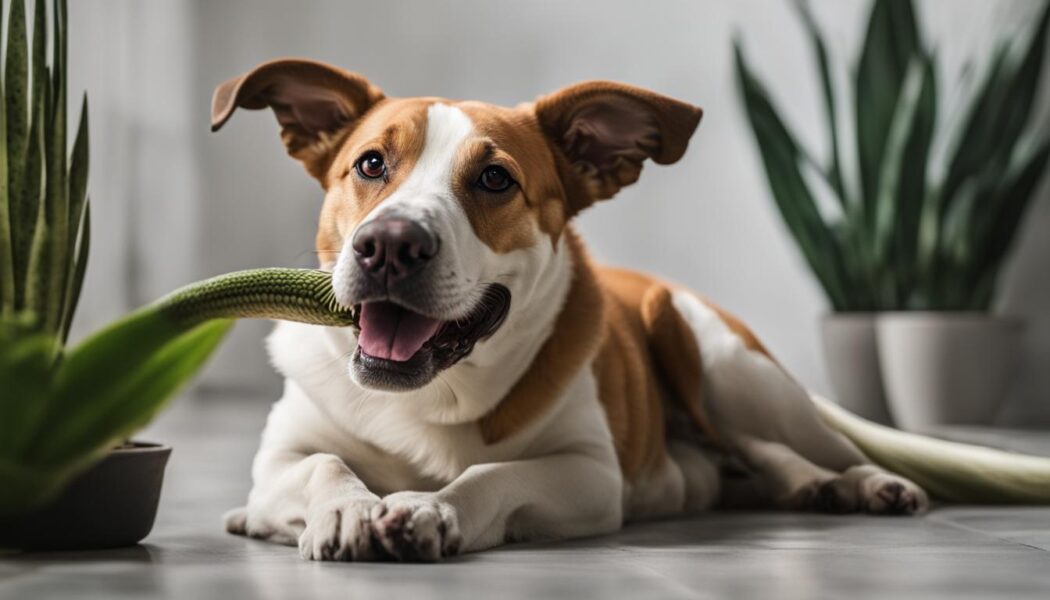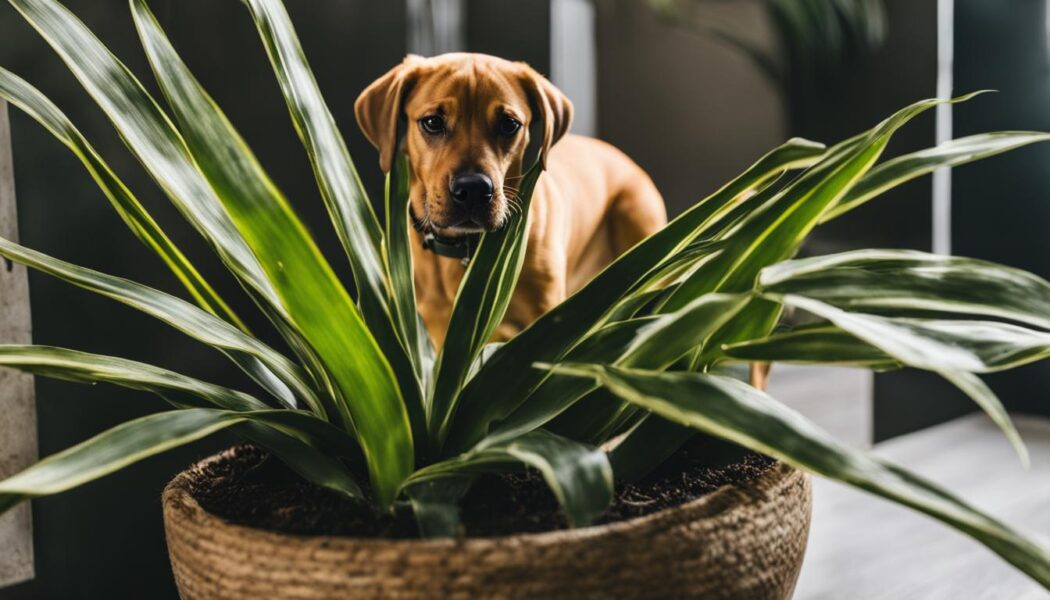As a pet owner, nurturing beautiful indoor plants alongside your canine companion may seem like the ideal living situation. Snake plants, in particular, are a popular choice, thanks to their air-purifying properties and striking appearance.
However, it’s essential to be aware of any potential dangers before introducing these plants into your home. In this comprehensive guide, we delve into the question: Are snake plants toxic to dogs? With a focus on pet safety, we’ll discuss the potential dangers associated with snake plants and provide dog-friendly alternative options for your indoor garden.
Key Takeaways
- Snake plants, or Dracaena trifasciata, contain saponins which are toxic to dogs.
- Possible symptoms of snake plant ingestion in dogs include vomiting, diarrhea, and lethargy.
- Immediate action, such as contacting a veterinarian, is required if your dog ingests a snake plant.
- There are a variety of non-toxic, dog-friendly indoor plants available to ensure pet safety at home.
- Prevention and awareness are vital for creating a harmonious environment for both your pets and plants.
Understanding Snake Plants and Their Appeal in Homes
Snake plants, also known as Dracaena trifasciata, are cherished for their resilience, low maintenance, and exceptional air-purifying capabilities. With origins in tropical Africa and Asia, they are recognized for significantly impacting indoor air quality by removing harmful toxins present in the environment. The decorative, sword-shaped leaves of the snake plant make it an attractive addition to any home interior, further increasing its popularity among plant enthusiasts. 
Despite these undeniable benefits, pet owners need to be cautious when choosing to include snake plants in their living spaces due to the potential threat they pose for their furry companions.
A balanced approach is essential for reconciling the appeal of snake plants and maintaining pet-friendly homes, especially concerning dog-safe indoor plants. To better understand the concerns associated with snake plants and dog toxicity, it is important to examine the plant’s properties and impact on the indoor environment.
- Sword-shaped leaves make for an aesthetically pleasing appearance.
- Low maintenance requirements make it easy to care for.
- Resilient in various conditions, making it suitable for various living spaces.
- Proven air-purifying capabilities contribute to a healthier indoor environment.
The following table presents a comparison of snake plant properties and their associated benefits and drawbacks in relation to pet safety and interior design:
| Property | Benefits | Drawbacks |
|---|---|---|
| Aesthetics | Attractive sword-shaped leaves enhance home decor. | No known drawbacks. |
| Maintenance | Requires minimal care, ideal for busy households. | No known drawbacks. |
| Resilience | Well-suited for various living spaces and conditions. | No known drawbacks. |
| Air-purifying | Removes harmful toxins and improves indoor air quality. | No known drawbacks. |
| Pet Safety | None | All parts of the plant are toxic to dogs; caution is necessary in pet-friendly homes. |
In closing, while snake plants offer numerous benefits, pet owners must remain vigilant to prevent these attractive houseplants from inadvertently causing harm to their beloved canine friends.
Prioritizing dog-safe indoor plants is key in maintaining healthy, harmonious pet-friendly homes without sacrificing visual appeal and air quality benefits. In subsequent sections, we will explore alternatives and safety measures to further ensure a safe and nurturing environment for your pets.
What Makes Snake Plants Toxic to Dogs?
Although snake plants are popular in households for their low maintenance, air-purifying capabilities, and aesthetic appeal, they are considered one of the poisonous plants for dogs. The toxicity of snake plants is attributed to a naturally occurring substance called saponins, which is present throughout the plant.
Let’s take a closer look at the role of saponins in snake plant toxicity and how it affects canine health.
The Mystery Ingredient: Saponins
Saponins are the primary toxic elements in snake plants, serving as a natural defense against pests, insects, and fungi. Found throughout the plant, these compounds are responsible for causing gastrointestinal irritation if ingested by dogs. Generally, the ingestion of saponins can lead to inflammation of the stomach lining and gastrointestinal tract, which results in the various symptoms of snake plant toxicity in dogs.

Potential Dangers: How Saponins Affect Canine Health
While the natural bitterness of snake plants typically deters dogs from consuming large amounts, significant ingestion of saponins can pose serious health risks to your pet. When dogs consume snake plants, saponins are released, mainly causing gastrointestinal issues.
However, more severe complications may arise, such as harm to red blood cells, leading to anemia and, in extreme cases, organ failure. As such, it is crucial for pet owners to be aware of the close relationship between snake plants and canine health.
The Myriad Symptoms of Snake Plant Toxicity in Dogs
If your furry companion ingests a snake plant, it is vital to recognize the signs of poisoning promptly to ensure their safety and well-being. The common symptoms of snake plant poisoning in dogs include:
- Excessive drooling
- Vomiting
- Diarrhea
- Abdominal pain
- Lethargy
- Depression
Swelling of the oral tissues and difficulty swallowing may also occur. In cases of severe poisoning, dogs may experience labored breathing, muscle tremors, or seizures. It is essential to act quickly to mitigate these symptoms and prevent any further complications.
In conclusion, it is crucial to understand the risks associated with snake plants toxic to dogs and take appropriate precautions to protect your canine companions. Being proactive in preventing snake plant ingestion and staying vigilant in observing any signs of poisoning will help ensure the safety and well-being of your beloved pets.
Navigating the Risks: Keeping Your Dog Safe
Protecting your dog from the potential dangers associated with snake plants is a priority for pet owners. There are several methods available to mitigate these risks, ensuring a harmonious and safe environment for your canine companion.
- Elevate the snake plant: This can be done by placing the plant on a high shelf or hanging it so that your dog cannot access it. Be sure to check that the chosen location is stable and secure to prevent the plant from falling.
- Employ deterrents: Using bitter sprays on the plant leaves can discourage your dog from approaching or attempting to chew on the plant. It is important to apply a pet-safe, non-toxic spray that is designed explicitly for this purpose.
- Provide alternative chewing options: Offer your dog a variety of safe toys and chews to keep them occupied and prevent them from exploring other potentially harmful items, like snake plants.

Another excellent approach for maintaining pet safety at home is to opt for dog-friendly indoor plants that pose no threat to your furry friend’s health. Considering alternative plants can help transform your living space while keeping your pet safe and secure. Below is a table comparing toxic and non-toxic plants for your home:
| Toxic Plants | Pet-Safe Plants |
|---|---|
| Snake Plant (Dracaena trifasciata) | Spider Plant (Chlorophytum comosum) |
| Lilies (Lilium spp.) | Areca Palm (Dypsis lutescens) |
| Pothos (Epipremnum aureum) | Boston Fern (Nephrolepis exaltata) |
| Rubber Plant (Ficus elastica) | Bamboo Palm (Chamaedorea seifrizii) |
When selecting plants for your home, be diligent in researching their toxicity to ensure they are compatible with your dog’s safety.
Remember to inspect both indoor and outdoor areas within your property and take necessary precautions to create a pet-friendly environment for your beloved canine.
Recognizing the Signs: Symptoms of Snake Plant Poisoning in Dogs
Being able to recognize the signs of snake plant poisoning can not only save your dog’s life but also prevent unnecessary suffering. If you suspect your dog has ingested a snake plant, it is critical to look out for the following symptoms of snake plant poisoning in dogs:
- Vomiting
- Diarrhea
- Excessive drooling
- Lethargy
- Lack of appetite

In addition to these symptoms, some dogs may experience difficulty breathing, swollen mouth and throat, or even seizures. Monitoring any changes in your dog’s behavior after suspected ingestion of a snake plant is paramount. Timely intervention can make a significant difference in the outcome and ensure a proper diagnosis and treatment.
Once you have identified the symptoms of snake plant poisoning in dogs, it’s crucial to reach out to your veterinarian and provide them with detailed information. This includes the type of snake plant your dog ingested, how much was consumed, the timing of ingestion, and any visible symptoms.
| Symptom | Description |
|---|---|
| Vomiting | Regurgitation of food or bile from the stomach |
| Diarrhea | Frequent, loose, or watery stools |
| Excessive drooling | Unusually large amounts of saliva, beyond what is considered normal for your pet |
| Lethargy | Decreased energy levels and overall weakness |
| Lack of appetite | Disinterest in food and refusal to eat |
As responsible pet owners, protecting our beloved dogs from snake plant toxicity is of utmost importance. By recognizing snake plant toxicity and promptly addressing the symptoms, you can help ensure proper care and ultimately save your dog’s life.
Immediate Steps: Actions to Take if Your Dog Ingests Snake Plants
If your dog ingests part of a snake plant, it is crucial to remain calm and promptly take necessary actions to ensure their well-being. There are several important steps to follow to minimize the risk of toxicity and provide your pet with quality care.
Emergency Response: How to React to Potential Poisoning
- Remove the snake plant from your dog’s reach to prevent further ingestion.
- Monitor your dog closely for symptoms of snake plant toxicity, such as vomiting, diarrhea, and lethargy.
- Note the specifics of the snake plant, including the variety and the amount ingested, to provide accurate information to the veterinarian or poison control center.
- Contact a veterinarian or a pet poison helpline to discuss whether immediate care is necessary for your dog’s situation.
- Do not attempt to induce vomiting or administer any treatment without professional guidance.
Seeking Veterinary Care: What to Expect at the Clinic
Upon arrival at the veterinary clinic, your dog will undergo a thorough examination to assess their condition and determine the appropriate course of action. Depending on the severity of symptoms and the time elapsed since ingestion, the veterinarian may recommend various treatments to help manage the symptoms of snake plant ingestion.
| Treatment | Description |
|---|---|
| Induced Vomiting | If ingestion is recent, the veterinarian may induce vomiting to help remove the toxic plant material from your dog’s stomach. |
| Activated Charcoal | Activated charcoal may be administered to help absorb toxins and reduce their absorption into your dog’s bloodstream. |
| Fluid Therapy | Dehydrated dogs may receive intravenous fluids to replenish lost electrolytes and support kidney function. |
| Medications | Depending on the severity of symptoms, medications may be administered to help manage pain, gastrointestinal distress, or other complications. |
| Blood Work and Urinalysis | These tests may be performed to assess organ function, electrolyte levels, and identify any underlying conditions that may have been exacerbated by the plant ingestion. |
By following these immediate steps for snake plant toxicity, you can be better prepared to handle emergency situations with your dog and ensure their safety in cases of accidental ingestion of poisonous plants.
Creating a Pet-Friendly Home with Safer Plant Alternatives
Creating a pet-friendly home begins with incorporating non-toxic plants for homes with pets. This means swapping out potential threats, such as snake plants, for safer alternatives. With a combination of aesthetically pleasing and pet-safe options, both your dog’s health and your passion for interior gardening can coexist harmoniously.
One of the keys to designing a secure environment is selecting plants that are not harmful to your furry family members. To help you make informed choices, here are some popular non-toxic plants:
- Boston Fern
- Spider Plant
- Cast Iron Plant
- Areca Palm
- Calathea
Keep in mind that while these plants are considered non-toxic to pets, individual reactions may vary, and it is essential to maintain supervision when introducing new plant life into the home. To provide a more elaborate view, the following table offers details on common non-toxic plants:
| Plant Name | Plant Description | Benefits |
|---|---|---|
| Boston Fern | Fern with feathery, green fronds that arch gracefully | Air purifying, adds humidity to the room |
| Spider Plant | Grass-like plant with long, slender leaves and tiny white flowers | Easy to grow, resilient, air purifying |
| Cast Iron Plant | Hardy plant with long, dark green leaves that grow upright | Low-light tolerant, low maintenance, air purifying |
| Areca Palm | Tropical palm plant with feather-shaped fronds | Indoor air purifier, adds elegance to the room |
| Calathea | Colorful, patterned plant with various shapes and sizes | Safe for pets, attractive appearance, air purifying abilities |
In addition to choosing pet-safe plants, it is essential to apply various strategies to ensure a pet-friendly home. Consider using deterrents, such as taste-based repellents, to dissuade pets from approaching potentially toxic plants. Regularly monitor your dog’s behavior around greenery and offer alternative chewing options, like toys or treats, to reduce incidents of ingesting plant parts.
By thoughtfully selecting non-toxic plants for your home and implementing safety measures, you can create a beautiful and serene indoor environment that accounts for the well-being of your canine companions.
Conclusion
Snake plants, though prized for their beauty and air-purifying properties, can pose a threat to our beloved canine companions due to their toxic nature. Snake plant toxicity in dogs is a concern for pet owners who must balance the allure of these plants with the safety and well-being of their furry friends. With proper precautions and awareness, it is possible to create a pet-friendly environment while enjoying the benefits of snake plants.
In order to maintain pet safety from poisonous plants, pet owners must be vigilant in monitoring their dogs for any signs of toxicity. Symptoms such as vomiting, diarrhea, and lethargy may indicate the consumption of a snake plant. Seeking immediate veterinary care is essential in these situations, as timely intervention can make all the difference for the dog’s health.
In conclusion, a responsible and informed approach to pet ownership includes selecting safe, non-toxic plants for your home and keeping a keen eye on your pet’s well-being. By doing so, you are ensuring dog well-being and fostering a harmonious living space in which both you and your canine companion can thrive safely together.
FAQ
Are snake plants toxic to dogs?
Yes, snake plants are toxic to dogs as they contain saponins, which can cause gastrointestinal irritation if ingested by dogs, leading to symptoms like nausea, vomiting, and diarrhea. In severe cases, it may cause ruptured red blood cells that require immediate veterinary care.
What are the symptoms of snake plant toxicity in dogs?
Symptoms of snake plant toxicity in dogs include excessive drooling, vomiting, diarrhea, abdominal pain, lethargy, depression, and swelling of the oral tissues. If you notice any of these symptoms, seek veterinary care immediately.
What should I do if my dog ingests a snake plant?
If your dog ingests part of a snake plant, immediately remove the plant from their reach and contact a veterinarian or poison control. Do not attempt to induce vomiting without professional guidance. Monitor your pet for any symptoms and note the type of snake plant and the amount ingested to inform the veterinarian for proper diagnosis and treatment.
How can I keep my dog safe from snake plant toxicity?
To keep your dog safe from snake plant toxicity, elevate the plants out of reach, use deterrents like bitter sprays, and provide alternative chewing options. Consider pet-friendly plants that pose no threat to dogs, and ensure all areas within your home, including outdoors, are free from toxic plants.
What are some dog-safe indoor plant alternatives to snake plants?
Some dog-safe indoor plant alternatives include Boston ferns, spider plants, African violets, and ponytail palms. These plants are non-toxic to dogs, making them suitable for a pet-friendly home environment.




